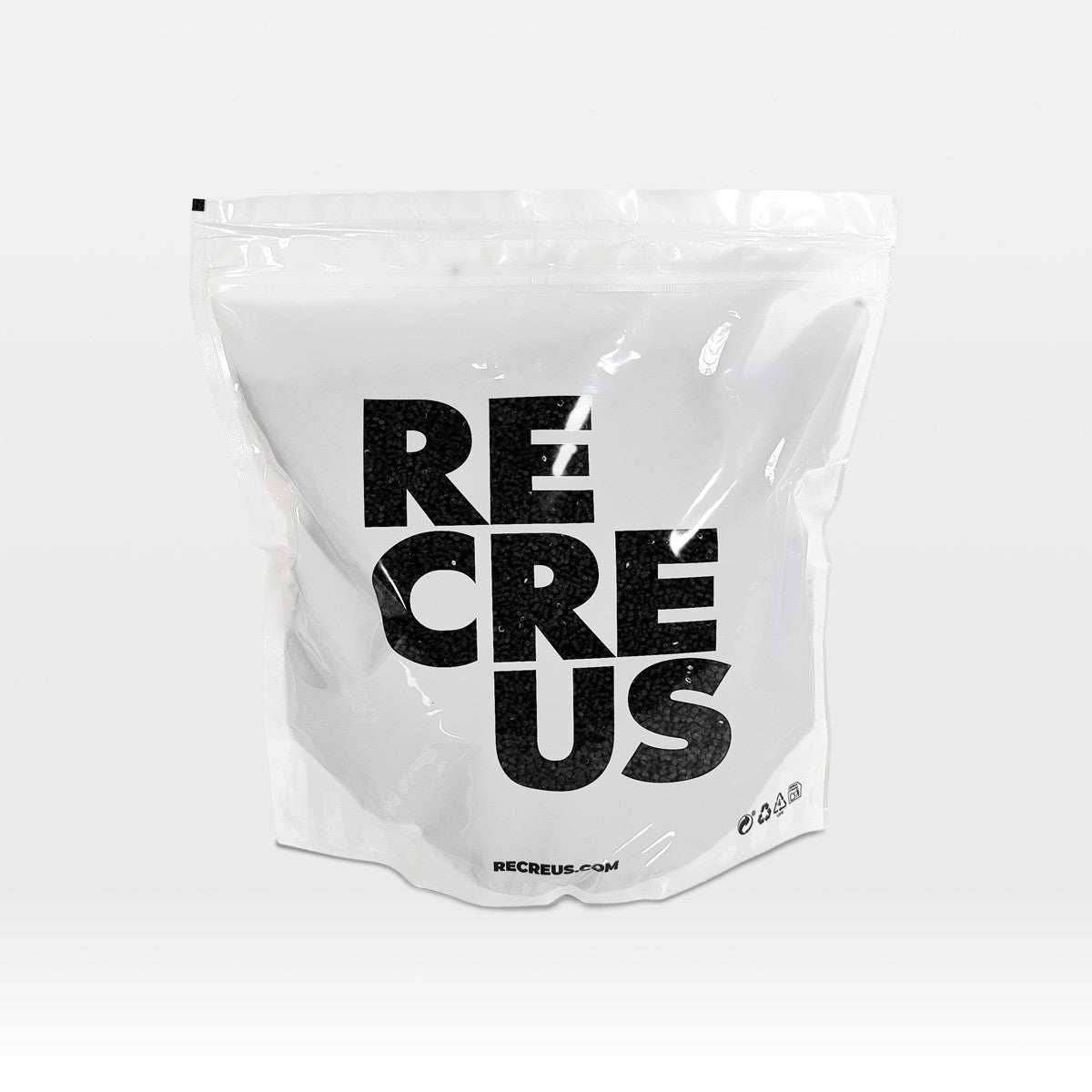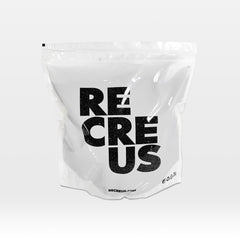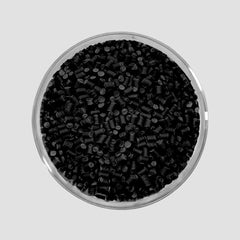



Conductive Filaflex Pellet
Conductive Filaflex Pellet is an electrically conductive and flexible material in pellet format, perfect for manufacturing functional components and wearable electronic devices.
- €42,90 EUR
€42,90 EUR- €42,90 EUR
- Unit price
- per
Couldn't load pickup availability
Conductive Filaflex Pellet is a groundbreaking material in the world of flexible 3D printing, featuring a unique combination of electrical conductivity and flexibility with a precise 92A Shore hardness. This innovative matrial opens new possibilities in the creation of functional electronic components and wearable devices, making it a game-changer for both prototyping and end-use applications.
With its optimal hardness level, Conductive Filaflex Pellet ensures exceptional compatibility with 90% of market-available 3D printers, eliminating the need for specialized hardware. The material's electrical resistance can be fine-tuned through printing parameters, making it ideal for low-current applications where precision and reliability are crucial. Our technical support team is available to guide you in optimizing the printing parameters for your specific application needs.
Key Features & Benefits
- Dual Properties: Electrical conductivity with flexibility
- Wide Compatibility: Works with 90% of 3D printers
- Flexible Electronics: Conductive circuits and pressure-sensitive buttons
- Wearable Tech: Direct printing on textiles
- Interactive Devices: Arduino keyboards, trackpads, joysticks
- Medical Applications: ECG patches and monitoring devices
Professional Applications
Complete Technical Printing Guide - CONDUCTIVE FILAFLEX
🌡️ 1. Material Preparation
Filament Drying (CRUCIAL):
- 📏 Temperature: 55°C
- ⏱️ Minimum time: 1 hour
- 💡 Proper drying is essential for optimal printing results
⚡ 2. Understanding Print Speed
Volumetric vs. Linear Speed
- 🌊 Volumetric Speed (mm³/s): Like water through a hose - measures how much plastic flows per second, regardless of nozzle size.
- 📏 Linear Speed (mm/s): Like walking speed - how fast the printer head moves across the print area
- 🔑 Key Formula: Linear Speed = Volumetric Speed / (Line Width × Layer Height)
✨ The Magic: When you set a volumetric speed limit in your slicer, it automatically calculates and adjusts all linear speeds (perimeters, infill, etc.) based on your current nozzle size and layer height. This ensures consistent material flow regardless of your print settings!
⚙️ 3. Basic Parameters
Unique Characteristics of Conductive Filaflex
Unlike rigid filaments, this conductive TPU stretches when extruded, producing thinner lines. The line width will be smaller than the nozzle diameter. To ensure proper conductivity and bonding between vertical walls and perimeters, adjust flow and temperature accordingly.
| Nozzle | Layer Height | Line Width | Volumetric Speed | Temperature |
|---|---|---|---|---|
| 0.4mm | 0.2mm | 0.38mm | 4.0 mm³/s | 250°C |
| 0.6mm | 0.3mm | 0.58mm | 9.0 mm³/s | 250°C |
| 0.8mm | 0.4mm | 0.78mm | 16.0 mm³/s | 252°C |
| 1.0mm | 0.5mm | 0.98mm | 25.0 mm³/s | 255°C |
🚀 4. Speed Settings
⚠️ NOTE: Speeds are calculated to ensure proper material flow and conductivity between layers.
0.4mm Nozzle (Volumetric Speed: 4.0 mm³/s)
| Line Type | Percentage | Speed |
|---|---|---|
| External Perimeter | 50% | 26.32 mm/s |
| Internal Perimeters | 75% | 39.47 mm/s |
| Infill | 100% | 52.63 mm/s |
| Top/Bottom | 60% | 31.58 mm/s |
| First Layer | 30% | 15.79 mm/s |
0.6mm Nozzle (Volumetric Speed: 9.0 mm³/s)
| Line Type | Percentage | Speed |
|---|---|---|
| External Perimeter | 50% | 25.86 mm/s |
| Internal Perimeters | 75% | 38.79 mm/s |
| Infill | 100% | 51.72 mm/s |
| Top/Bottom | 60% | 31.03 mm/s |
| First Layer | 30% | 15.52 mm/s |
0.8mm Nozzle (Volumetric Speed: 16.0 mm³/s)
| Line Type | Percentage | Speed |
|---|---|---|
| External Perimeter | 50% | 25.64 mm/s |
| Internal Perimeters | 75% | 38.46 mm/s |
| Infill | 100% | 51.28 mm/s |
| Top/Bottom | 60% | 30.77 mm/s |
| First Layer | 30% | 15.38 mm/s |
1.0mm Nozzle (Volumetric Speed: 25.0 mm³/s)
| Line Type | Percentage | Speed |
|---|---|---|
| External Perimeter | 50% | 25.51 mm/s |
| Internal Perimeters | 75% | 38.27 mm/s |
| Infill | 100% | 51.02 mm/s |
| Top/Bottom | 60% | 30.61 mm/s |
| First Layer | 30% | 15.31 mm/s |
↩️ 5. Retraction Settings
🚀 IMPORTANT: Set travel speed to the maximum your machine allows (200-500mm/s). Faster movements reduce filament oozing time, minimizing stringing.
| Nozzle | Distance | Speed | Z-Hop |
|---|---|---|---|
| 0.4mm | 1.5-2.0mm | 20mm/s | 0.2mm |
| 0.6mm | 1.5-2.0mm | 20mm/s | 0.2mm |
| 0.8mm | 1.5-2.0mm | 20mm/s | 0.2mm |
| 1.0mm | 1.5-2.0mm | 20mm/s | 0.2mm |
🌡️ 6. Bed Temperature Settings
Bed Temperature:
- Small parts: No heating (room temperature)
- Large parts: 50-55°C
❄️ 7. Cooling Settings
Cooling Configuration:
- General: 0% (fan off)
- KEEP FAN ALWAYS: OFF
- Force fan speed for overhangs and bridges: OFF
- Layers < 10 seconds: 40% fan
- First layer: Always 0%
🔧 8. Troubleshooting Guide
| Problem | Solution |
|---|---|
| Irregular extrusion | 1. Dry the filament 2. Check extruder 3. Reduce speed |
| Poor adhesion | 1. Dry the filament 2. Use adhesive 3. Adjust first layer |
| Stringing | 1. Dry the filament 2. Adjust retraction 3. Increase travel speed 4. Check temperature |
✨ 9. Best Practices
- 🌡️ Keep filament dry - store properly and dry before use
- ⚙️ Preferably use direct drive extruder
- 🔄 Print multiple small parts simultaneously for better results
- 🚀 Use maximum travel speed to minimize stringing
⚠️ PLEASE NOTE: These printing parameters are initial recommendations based on our experience. They may need adjustment depending on your specific 3D printer, environmental conditions, and the geometry of the part you are printing. Use these settings as a starting point and fine-tune them according to your specific needs.
Related Products
- from €42,90 EUR
€42,90 EUR- from €42,90 EUR
- Unit price
- per
- from €42,90 EUR
€42,90 EUR- from €42,90 EUR
- Unit price
- per
- from €42,90 EUR
€42,90 EUR- from €42,90 EUR
- Unit price
- per
- from €42,90 EUR
€42,90 EUR- from €42,90 EUR
- Unit price
- per
- from €42,90 EUR
€42,90 EUR- from €42,90 EUR
- Unit price
- per
- from €42,90 EUR
€42,90 EUR- from €42,90 EUR
- Unit price
- per
- from €42,90 EUR
€42,90 EUR- from €42,90 EUR
- Unit price
- per
- from €42,90 EUR
€42,90 EUR- from €42,90 EUR
- Unit price
- per
- from €42,90 EUR
€42,90 EUR- from €42,90 EUR
- Unit price
- per
- from €42,90 EUR
€42,90 EUR- from €42,90 EUR
- Unit price
- per
Latest Posts
Beyond Design: How Fornice Objects Is Transforming 3D Perception with Filaflex 95 Foamy
G-Tac and Filaflex: Flexible Innovation for Defense, Industry, and Food
Filaflex: The Perfect Flexibility for Custom Orthopedics
Recently Viewed Products
- from €42,90 EUR
€42,90 EUR- from €42,90 EUR
- Unit price
- per
- from €42,90 EUR
€42,90 EUR- from €42,90 EUR
- Unit price
- per
- from €42,90 EUR
€42,90 EUR- from €42,90 EUR
- Unit price
- per
- from €42,90 EUR
€42,90 EUR- from €42,90 EUR
- Unit price
- per
- from €42,90 EUR
€42,90 EUR- from €42,90 EUR
- Unit price
- per
- from €42,90 EUR
€42,90 EUR- from €42,90 EUR
- Unit price
- per
- from €42,90 EUR
€42,90 EUR- from €42,90 EUR
- Unit price
- per
- from €42,90 EUR
€42,90 EUR- from €42,90 EUR
- Unit price
- per
- from €42,90 EUR
€42,90 EUR- from €42,90 EUR
- Unit price
- per
- from €42,90 EUR
€42,90 EUR- from €42,90 EUR
- Unit price
- per
- Choosing a selection results in a full page refresh.












